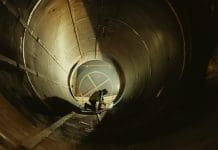Despite a recent attempt at regulation falling by the wayside, the issue of embodied carbon in buildings has never been more prominent in construction. But as Mike Stevenson of NorDan UK explains, when you think longer-term about building specification, the carbon reduction takes care of itself
According to the World Green Building Council (World GBC), embodied carbon emissions generated by construction materials and processes, are responsible for 50 million tonnes of UK carbon emissions every year, and account for 11% of total global carbon emissions.
Operational carbon, from the day-to-day running of buildings, accounts for 28%, and to date, has been the main focus of UK legislation and reduction efforts.
Improvements to thermal standards of buildings have been impressive, and the World GBC believes that with the projected growth of global construction, operational and embodied carbon will be on par by 2050.
The rise and fall of Part Z
The Carbon Emissions (Buildings) Bill, or ‘The Part Z’ bill, was shelved four days before its second reading because its champion Duncan Baker MP, has taken a new job within the government that doesn’t allow him to pursue it.
The Part Z bill would have been significant for the construction industry, as it aimed to create the UK’s first legislation that would require the measurement of embodied carbon in buildings.
Embodied carbon comes from the extraction of the materials, product processing or manufacturing, transport, installation into buildings, and then the disposal of materials at the end of their life.
The bill would have set mandatory limits for embodied carbon emissions on all building projects over 1,000m2 from 2027, requiring builders to assess and report on the whole life carbon on non-residential projects over 1,000m2 from 2023 and all residential projects from 2025.
Although it is disappointing that the Part Z bill has been shelved for the time being, it is now clear that the construction industry has acknowledged that embodied carbon needs to be addressed in order to meet our net-zero targets.
Tackling embodied carbon in buildings
Reducing operational carbon through energy efficiency has made homes warmer, more comfortable, and healthier, and is also helping to address rising fuel costs and fuel poverty.
Building regulations and technical standards legislation have improved thermal performance and airtightness, and the Future Homes Standard sets out a clear path forward.
So with operational carbon in hand, the time has come for the industry to get serious about embodied carbon.
Over a thirty-year career, I’ve worked across all the major window and door materials, but have spent my most recent years working with timber.
I read a recent quote from the Timber Research & Development Association (TRADA) that said: “CO₂ released now is worse than CO₂ released in the future. There is not actually much point in getting to the future unless we do a good enough job at controlling CO₂ emissions now.”
In other words, it makes no sense for the industry to generate huge amounts of unnecessary carbon making both existing and new buildings operationally carbon efficient, as it risks making climate change worse sooner.
Measuring and reporting the whole life carbon
If we want to reduce the whole life carbon of every aspect of a building, then we first need to know what embodied carbon our specification and material choices will generate.
When it comes to better understanding the carbon in building products, then manufacturer Environmental Product Declarations (EPDs), are a good place to start.
EPDs are objective, third party reports that give clients, architects, specifiers and contractors the ability to assess the data they need to make better decisions.
NorDan has invested in gaining EPDs across the majority of our products – one of the few fenestration companies to have made this commitment, and we refresh and add new declarations as our range evolves through continuous improvement and expansion.
I fully accept that NorDan is at an advantage when it comes to EPDs. Our products are manufactured from over 95% timber, which is carbon negative, and the vacuum impregnation with preservative and thin layer of aluminium cladding gives them a sixty year plus life expectancy. This makes our EPDs impressive reading if your specification is being led by a longer-term or whole life approach.
The benefits of timber are easy to decipher, but in reality, cost-driven, short-term decision making often results in homes and buildings that are cheaper to build, but do little for the planet and certainly won’t help to address the climate emergency.
Short-term specification decisions curse buildings with a negative environmental impact from day one – issues that cannot be retrieved or reduced without generating more carbon putting things right.
A long term approach to building specification
I saw the Part Z Bill when placed alongside the whole life cost of building products, as an opportunity for the industry to take a holistic approach to building specification. This is because specifying the correct building materials supports the long term relationship between social, economic and environmental values. In other words, true sustainability.
A useful example of how aspirational specification has delivered long-term social, environmental and economic benefits for multiple stakeholders in the Castle Court housing development in Sheffield.
In the late 1980s, Sheffield City Council sought to refurbish the then dilapidated 1960s development to provide athlete accommodation for the 1991 World Student Games, and beyond that, the legacy of quality social housing.
Using the games as a catalyst for investment, NorDan’s high specification StormGuard aluminium-clad timber windows were installed in all 240 apartments over 13 floors.
Thirty years on, not a single NorDan StormGuard window has required maintenance or replacement, and the unique tilt and turn mechanisms still operate perfectly. The homes are dry, airtight and warm.
PVCu or aluminium windows would have been a cheaper refurbishment option, but both would have needed to be replaced by now.
NorDan’s StormGuard windows still have at least another thirty years in them due to the vacuum impregnated timber and FOX anodised aluminium cladding.
Today, Castle Court remains one of the most sought after social housing developments in Sheffield.
Castle Court perfectly demonstrates how good decision making around specification can deliver my earlier point on true sustainability. By choosing to specify high performance, highly durable, low-maintenance products for this refurb project, the long term relationship between social, economic and environmental values, including whole life carbon, has been able to align. It makes sense on every level.
Let’s hope this is a lesson being learned across the industry.
Mike Stevenson

Senior manager of strategic markets
NorDan UK
LinkedIn: Nordan Uk Ltd
Twitter: @nordanuk














